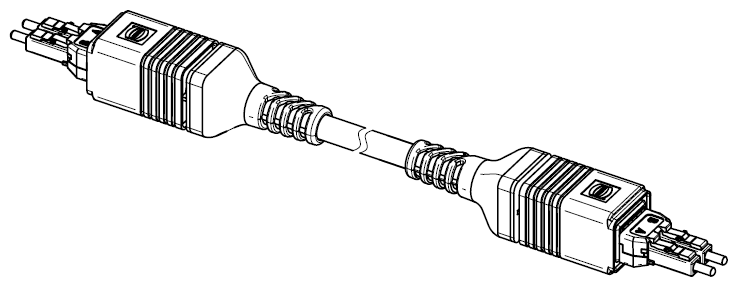Optical fiber cables
General information on optical fiber types
Optical fiber are available as multimode and single mode types with different step and graded indices.
Step and graded index
Optical fiber cables consist of 2 concentric materials – the core and a cladding. These may be surrounded by a (colored) protective sheath. The core and the cladding have a different refractive index, causing the light waves (modes; a mode is a natural wave in the optical fiber) to be reflected back into the core at the boundary. Due to the step change in the index of refraction this type of fiber is referred to as step index. A gradual/parabolic transition between the index of refraction in the core and the coating (referred to as graded index) can be achieved by mixing the materials. In a graded index fiber the modes are gradually diffracted back to the core, leading to propagation-time compensation and significantly higher quality of the light pulse at the outlet compared with a multimode step index fiber, where the different light modes have different signal propagation delays (mode dispersion) with associated front distortion.
Single mode
Single mode fiber cables have a very thin core (9 µm) and therefore conduct only a single light mode with high signal quality and almost without mode dispersion. They are only available as step index fibers. Due to the high signal quality they are suitable for large transmission bandwidths > 10 GHz*km and distances > 50 km. The refractive index profile of single-mode fibers is dimensioned such that the multipath propagation (intermodal dispersion), which is a problem with multi-mode fibers, is omitted – the signal light propagates in a single-mode fiber only in a single guided fiber mode, hence the designation ‘single-mode’. This makes considerably larger transmission distances and/or transmission bandwidths possible, and the limiting effect that arises next is the color distortion of the transmitted mode.
Multimode
Multimode fiber optics are manufactured as step index or graded index. Step index multimode fiber cables are suitable for transmission bandwidths up to 100 MHz*km and distances up to 1 km. Graded index multimode fiber cables with core diameters between 50 and 62.5 µm reach transmission bandwidths > 1 GHz*km and ranges > 10 km. Multimode means that the core of the optical fiber cable is thick enough to enable several light modes of the light employed to propagate reflectively in the cable.
Use with the EP9521-0020
The EP9521-0020 is intended for combination with multimode optical fiber cables with the following properties:
- LC Duplex plug or, in the IP67 version, PushPull LC Duplex Multimode plug (SFP version) made by HARTING

Optical fiber cable with LC Duplex Multimode plugs - Multimode cable 62.5/125 µm or better 50/125 µm
 | Recommended connectors The PushPull LC DUPLEX plug by HARTING is compulsory for IP67 use of the box. The mechanical construction guarantees the leak-tightness and suitable height offset of the fiber-optic plugs inside the protective housing. The plug is available from Beckhoff as a set of 10 under the order designation ZS1091-0001. Processing requires experience in the assembly of optical fiber cables! |
 | 50/125 µm or 62.5/125 µm The use of both diameters is possible. However, the use of 50/125 µm is recommended due to the lower attenuation. |
In optical fibers the wavelengths 850 and 1300 nm are usually used for data transfer. The optical fiber cables available on the market are mostly optimized for use in one of these ranges, since the attenuation of the signal (as with copper cables) is frequency-dependent – long ranges of several km can then be achieved with the respective wavelength. In general, optical fiber cables in the 1300 nm window exhibit a lesser attenuation than in the 850 nm window.
In the EP9521-0020 a transceiver with the wavelength of 1300 nm is used.
 | Range and bandwidth product Optical fiber cables are available in different qualities from reputable manufacturers. One of the relevant parameters for the user is the frequency-dependent bandwidth product of a cable, specified in [MHz x km]. The greater the bandwidth product, the lower the attenuation, and therefore the larger the range that can be achieved with this cable (see ITU-T G-651). For achieving the maximum range, optical fiber cables with a maximum bandwidth product of 1300 nm should therefore be used; we recommend using class OM2 optical fiber cables (EN50173:2002). |
 | Routing notes The following parameters must be taken into account in the installation of optical fiber cables
|
Further information can be found in the following documents:
- ITU recommendation ITU-T G.651 - G.655
- EN 50173:2002
- EN 60793-2
Connecting the optical fiber cable to the box
So as not to damage the optical fiber cable, never pull the cable when disassembling, always pull the plug which releases the catch!
 | Use of crossed optical fiber cables Please note that when connecting two EP9521-0020 modules together, crossed cables must be used in order to establish a connection. |

 | Use of blind plugs To protect the transceiver from environmental influences, unused connection socket should be sealed with the blind plugs provided! |